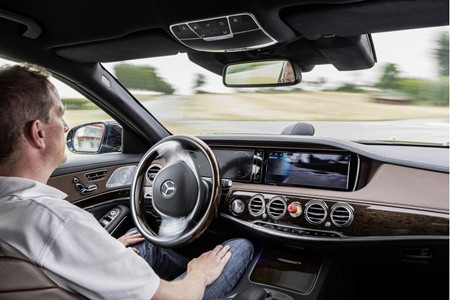Most of the major automobile manufacturers have moved on from experimental hybrids to autonomous cars, which will whisk us to our destination with a silent “chauffeur” dealing electronically with all the usual road hazards.
To show just where Mercedes-Benz are in this timeline they demonstrated their Mercedes-Benz S500 Intelligent Drive autonomous prototype, recreating the historic drive of Carl Benz’ wife Bertha.
In August 1888, Bertha Benz started off on the first long-distance automotive drive in history in the Patent Motor Car of her husband Carl Benz, thus paving the way for the worldwide success of the automobile. Her route, which ran southward from Mannheim to Pforzheim for around 100 km, was used by Mercedes-Benz developers as the real test track for another pioneering achievement in mobility exactly 125 years later: proof of the suitability of autonomous drive systems for everyday use in the highly complex environment of overland and urban traffic.
 Drive me home, James!
Drive me home, James!
“This S-Class spells out where we’re headed with ‘Intelligent Drive’ and what tremendous potential there is in currently available technology,” says Dr. Dieter Zetsche, chairman of the Board of Management at Daimler and Head of Mercedes-Benz Cars.
“With our successful test drives, we have demonstrated that highly automated driving is possible without the luxury of specially closed-off sections of road and relatively straightforward traffic situations,” says Thomas Weber, member of the Board of Management at Daimler with responsibility for Group Research and Head of Mercedes-Benz Cars Development.
This experience will now be incorporated into the engineering of future vehicle generations to be equipped with such innovative, further-developed functions. Thomas Weber stresses: “With the new S-Class, we are the first to drive autonomously during traffic jams. We also want to be the first to provide other autonomous functions in series production vehicles.
The now successfully conducted autonomous test drives along the Bertha Benz route allowed the Daimler researchers to gather important information on the challenges that remain to be addressed on the way to highly and fully automated driving and what, for example, still needs to be done to enable a car to navigate safely in highly complex situations.
Improvements were made to the number and arrangement of the sensors in order to achieve comprehensive coverage of the vehicle’s surroundings in every direction, and to obtain additional information on the area around the vehicle. Examples of specific technical modifications compared with the standard-production version of a Mercedes-Benz S-Class are the enhancement of the base width (distance between the eyes) of the stereo camera to allow more-distant objects to be detected not only by the radar system, but also by the camera, and a new color camera for the monitoring of traffic lights.
The autonomous research vehicle records the entire sensory data collected by the vehicle, which flows in at a rate of 300 gigabytes per hour from the images of the stereo camera alone.
Based on these sensor data and determination of the vehicle’s own position with reference to information from a digital map, an autonomously driving vehicle analyzes the available free area for driving and plans its own route. In addition to the road layout, this map – which must meet special requirements with regard to accuracy – includes information on the number and direction of traffic lanes and traffic signs as well as the positions of traffic lights. Digital maps of this kind are a key prerequisite for autonomous driving.
The autonomously driving S-Class was monitored during the tests by specially trained safety drivers who, whenever the system made an incorrect decision, were able to intervene immediately and take over control of the vehicle. A record was made each time it became necessary for the safety driver to take over control of the vehicle. This information was then evaluated by the development team, thus making it possible to extend the vehicle’s repertoire of maneuvers. This advances the development of the technology platform, enabling it to cope with more and more traffic situations.
A particular challenge for autonomous vehicles is the way in which they communicate and interact with other road users. Coming to an agreement with an oncoming vehicle on who should proceed first around an obstruction is something that requires a very great deal of situational analysis. Where a human driver might boldly move forward into a gap, the autonomous vehicle tends to adopt a more cautious approach. This sometimes results in comical situations, such as when, having stopped at a zebra crossing, the vehicle gets waved through by the pedestrian – yet the car stoically continues to wait, because M-B failed to anticipate such politeness when they programmed the system. (Local readers will understand that this situation will never happen in Thailand!)
I have no doubt that driving oneself to the shops will have a totally different meaning to it in five years, though it will probably be 10 years before it becomes commonplace. One of the biggest hurdles will be the litigation aspect. When an autonomous car collides with me self-driven one – who is to blame?




